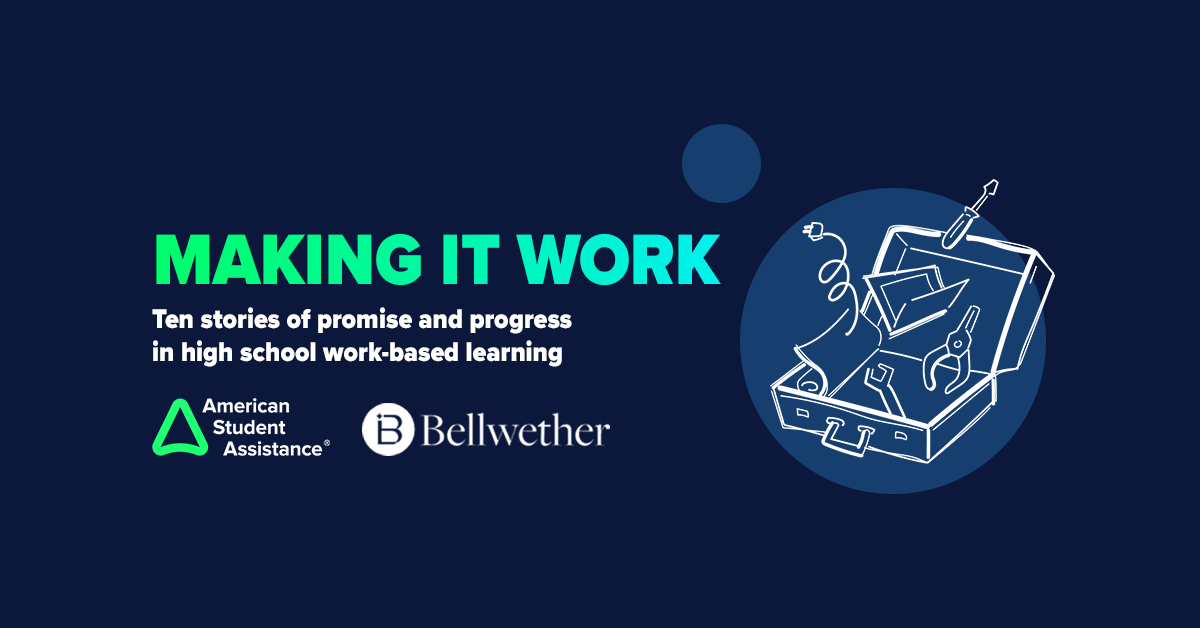At American Student Assistance, our goal is to increase the number of states committed to ensuring all youth younger than 18 have equitable access to robust, high-quality work-based learning programs, with policies in place to support program funding, infrastructure, quality, and accountability.
To that end, we recently released the comprehensive guide, High School Work-based Learning: Best Practices Designed to Improve Career Readiness Outcomes for Today’s Youth. We hope this informative resource provides state education leaders, educators, employers, community-based organizations, and other stakeholders with the information and insight they need to expand program access and enhance program quality in their own regions.
In the coming weeks, this blog will highlight the best practices compiled in the guide, along with insights from the education leaders who are successfully implementing these practices in their own states. We begin with the fundamental foundation of any work-based learning program – ensuring equal access for all students, regardless of gender, race, ethnicity, income level, disability status or academic path.
While most states do not impose strict restrictions on which students can participate in work-based learning opportunities, some do set eligibility requirements that limit the number and type of students who can participate. A handful of states impose no restrictions from the state level, but allow local districts to define eligibility, creating differences in opportunity across districts and potentially confusing variability from district to district. Some states set age (typically 16+) or grade (typically 11th or 12th) requirements to ensure compliance with state labor laws. Other states have changed labor or insurance regulations at the state level to make work-based learning for younger students more possible, and to reduce barriers to employer participation.
Ohio’s minor labor laws, for example, loosen the labor requirements and explicitly exempt students participating in a career-technical or STEM program approved by the Ohio department of education, or in any eligible classes through the college credit plus program (Ohio’s dual enrollment program) that include a state-recognized pre-apprenticeship program. Similarly, Connecticut created a waiver from state regulations that place age restrictions on participation in work-based learning opportunities in certain industries. These policy changes aim to make work-based learning more accessible for students and remove barriers to employer participation.
A more common way for states to restrict eligibility is by embedding work-based learning exclusively in career and technical education (CTE) programming, or to make work-based learning opportunities available only in advanced level CTE courses that require students to have taken one or more prerequisite course. Two states, Delaware and New Mexico, have two different approaches to this problem – ensure all students are eligible for CTE and thus work-based learning, or remove CTE requirements from work-based learning. Delaware requires all students to take at least three CTE courses in a pathway to graduate and all Delaware students are eligible to participate in CTE. As a result, all students are eligible to participate in a work-based learning program. New Mexico, meanwhile, deliberately prioritizes building work-based learning programs for all students, and not just CTE concentrators, due to the low percentage of students concentrating in CTE statewide.
“At least in my state, CTE concentrators are only about 12% of my student population,” Elaine Perea, PhD, Director of College and Career Readiness at the New Mexico Public Education Department, explains. “If I build all my programs for students who are in CTE, I’m missing 88% of my student population. And that means at a policy level pulling it out of CTE and making sure that the structures are there.”
One of the ways New Mexico quickly expanded work-based learning opportunities for all students, not just CTE concentrators, during the pandemic was by directing funds from the Elementary and Secondary School Emergency Relief Fund, authorized under the Coronavirus Aid, Relief, and Economic Security Act, to individual counties to pay youth in summer jobs. “What we found is that the counties are actually a really good partner, because they know who the community players are at the state level. In many of our counties they went directly to the Council of Governments or the local chambers of commerce and they were able to ramp up super quickly.”
New Mexico also prioritizes wider access to work-based learning because of its potential to address broader social issues. “Work-based learning is sometimes overlooked as a solution to help address deep-seated societal structural problems like multi-generational poverty,” says Perea. “Only about 40% of eligible adults in New Mexico between the ages of 25 and 55 are engaged in work. We have generations that have never worked inside the legitimate economy. I see work-based learning as an opportunity to change that intergenerational dynamic, to give young people the simple experience of joy to work. Young people who have never experienced that joy of work are more likely to follow their families’ path. But if you can give them the experience of contributing and being paid for that contribution, it can change your societal direction.”




